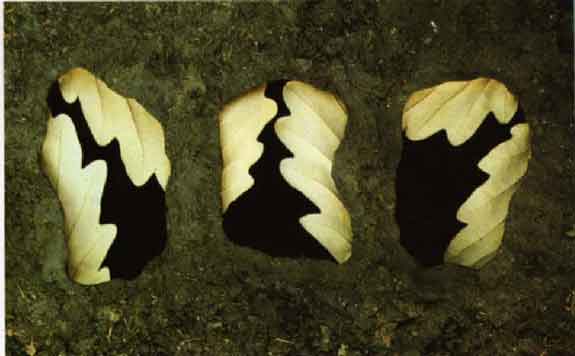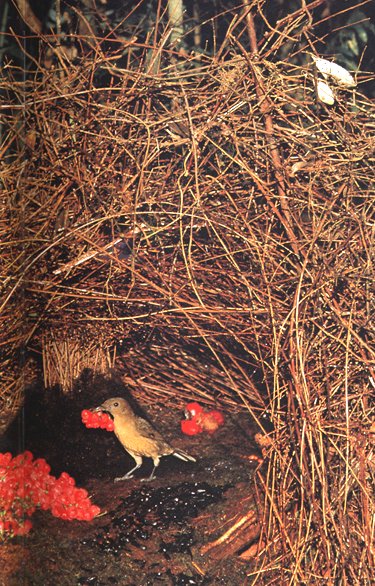Sculptures of Spring '08
Emily Bzdyk
Project 2- Kinetics and Interactivity
ARTIST RESEARCH
I am interested in the sculpture movement that focuses on the environment as a palette, using nature as the setting and material for artmaking. This movement, termed Earthworks, Land Art, or Earth Art, began in the 1960’s as a way to depart from artificiality. One of the main artists whose work comes to mind is Robert Smithson. There are many others, including Michael Heizer, David Medalla, Dennis Oppenheim, James Turrell, and Andy Goldsworthy. All the land art pieces feature some kind of site-specific environment installation. A big part of this idea is to get out of the studio. This method of getting people to think of art in a new way removes art from the formal setting of a studio or gallery. The work becomes part of the environment and is left to forces of nature like erosion and change.
Robert Smithson’s earthworks are large-scale alterations that work with the landscape. Perhaps his most famous is the spiral Jetty of Salt Lake. This piece, done in April 1970 is sometimes completely hidden depending on the surrounding water level. It is huge, 1500, feet long and extends out into the lake waters. There are other works, such as a house partially engulfed by earth, and an asphalt landslide down a slope that illustrate relationships between humans and our natural surroundings. He found areas that were already disturbed to be particularly intriguing. These types of works are interactive purely because of their scale and site-specific locations. TO experience the works, you have to confront them, and they become at least part of your physical location, if not your entire surroundings.
The Salt Jetty is so large that you are engaged by its physicality. Another aspect of earthworks is that they are typically out in the wilderness. For this reason, one of the main aspects of these works which I find addresses interactivity is the fact that you have to go on a journey to see most of them. The Salt Jetty must be driven to, there are numerous boundaries, such as cattle gates, and rocky roads. At some point you must park and get out and walk. This forces you to confront the terrain, the very terrain that is used to construct the Jetty. This confrontation of the environment in order to see the alteration brings you out into the element that surrounds and creates the art. Once you complete the pilgrimage to the jetty, the water level makes the presentation of the jetty variable. There is another jetty as well, which is leftover from oil drilling explorations, so Smithson’s work is sort of a more frilly creation of a completely functional construction.

Of course, Smithson has bodies of work which are less grounded in interactive nature. His mirror and salt pieces “mirror displacement” reverse the art-in-land. For this show he put land into his art. This reversal brings his raw elements into the gallery, which with the mirrors creates interesting spaces for viewers to experience. I would argue that these works continue to create a level of interactivity with the audience, mainly due to the reflective nature of mirrors. Some of the mirror’s surface is obscured by material, but the rest reflects the room, bringing a very basic level of interaction into the piece. The space enters the art.
Another interactive quality of these earthworks is the role of change and environmental impact. Andy Goldsworthy’s works are transient, or ephemeral. Nature reclaims his alterations, and they only exist for a limited time as he makes them. Because of this impermanence, the fleeting nature of beauty is emphasized, and the power and ever-changing natural world interacts with his interactions. Because he uses natural elements in his pieces, he is interacting with his environment, and than it reacts to his alterations with a passive dismissal that reminds us how the world continues on regardless of our affecting actions. This back and forth relationship is what makes his works not only fascinating and time limited, but an excellent example of interactivity in art.

Goldsworthy uses the found objects of nature and his own hands as tools, to amazing outcomes. “Iris Leaves with Rowan Berries” and “Oak Leaves and Holes” show us how Goldsworthy has created these temporary interactions of natural objects to create art. These pieces are a discovery process for him, as he explores and attempts to tap the processes of nature. The materials he uses have to be sensitive to the constant change which defines nature. The works “grow, or stay or decay”

On another note, the arrangement of flashy or particular natural materials reminds me of the bowerbird of New Guinea. The males of these species collect items and arrange them in intricate displays around their bower. These are structures which may be designed like a hut, or like one or two columns. These are made of sticks and are constructed entirely by the male bird. He arranges the area meticulously in hope that visiting females will be impressed by his creations and collections. These birds are making this “art” for the purpose of displaying their genetic qualities, which can be evidenced by their abilities to build and collect effectively.
Watch this video to learn more about bowerbirds!
Sources:
http://www.spiraljetty.org/
http://renaissancesociety.org/site/Exhibitions/Intro.171.0.0.0.0.html
http://www.robertsmithson.com/earthworks/Spiral_Jetty_03.htm
http://en.wikipedia.org/wiki/Robert_Smithson
http://www.morning-earth.org/ARTISTNATURALISTS/AN_Goldsworthy.html
http://en.wikipedia.org/wiki/Vogelkop_Bowerbird
www.hawaii.edu/lruby/art359/contemps.htm
St. Mary's College of Maryland
St. Mary's City MD 20686-3001
Back to Index
This page was last updated: February 17, 2008 2:15 PM